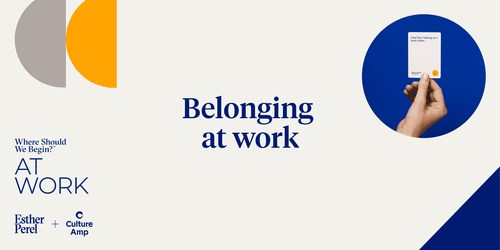
Article
Written by

Global Senior Director of Customer People Science at Culture Amp
From Boomers to Millennials and more, each generation of workers has a unique point of view. These groups differ not because humans have “evolved” but because they each grow up and grow old in different time periods with varying opportunities and challenges.
Generational categories represent a shorthand for describing attitudes, interests, beliefs, and experiences that certain groups of people are likely to have in common. They are not absolute statements about what all people of a certain age think or feel. There can be a lot of variation within and across generations, especially when you consider other demographics such as race, nationality, and class.
From an HR standpoint, the are four generations that have the most impact on work today. These are:
It’s this most recent cohort, Gen Z, that fellow People Scientist Myra Cannon and I presented research on during a one-hour webinar. Gen Z represents more than 20% of the overall U.S. population, and with the eldest now graduating college, workplaces need to be ready for them.
Important events and their repercussions shape the generations who live through them and those who merely read about them in different ways. For each generation, these and other aspects of the political, social, and economic landscapes define how they look at the world and what they expect their future to be like. You can think of it in broad terms as Boom and Bust Mindsets.
Generations with Boom Mindsets expect to thrive as adults. They believe:
Generations with Bust Mindsets expect to struggle as adults. They believe:
This mindset difference helps to explain why Boomers and their children, the Millennials, are so frequently at odds, while research suggests that Gen X and their kids in Gen Z often have more collaborative relationships. Millennials expected to reap the benefits of the Boomer’s experiences fighting for greater gender parity in the workplace, flexibility, and some degree of meaningfulness in work.
On the other hand, Gen X is a generation that has struggled both culturally and financially. Never large enough to be a focus of marketing efforts, they’ve been left to mostly fend for themselves and have conferred those expectations onto their children. A lot of the research on how Gen Z is planning out their future and how they interact with their parents reflects this shared perspective.
Given this context, the results of studies looking at Gen Z in the workplace take on renewed importance. They’re more than interesting tidbits – this research provides a meaningful understanding of likely behaviors and preferences for the latest generation to enter the workforce. We discuss these insights and how companies could respond in four categories: economic insecurity, coaching vs. managing, mental health and wellness, and workplace design.
As noted earlier, Gen Z has had a childhood marked by deep uncertainty around money and career, especially the value of college and its connection with a reliable future.
As a result, we see statistics emphasizing Gen Z plans for self-determined careers with a significant wariness of debt. For example, a quarter of Gen Z respondents believe they need to get through school with no debt, and 63% want to study entrepreneurship in college.
Perhaps most telling is that 42% of Gen Z respondents expect to work for themselves one day (this is about 4x higher than the actual percentage of self-employed Americans). This becomes more extreme when you account for race/ethnicity, with about 60% of African Americans and Hispanics expecting to work for themselves compared with only 31% of White respondents.
Gen Z is expecting to go it alone – they are not planning on how to be the best employee but rather how to survive as a freelancer or a competitor.
Implications for companies:
Generation Z reports that they are used to being trusted by their parents, and while they frequently consult parents for advice, they expect to make independent decisions. Requests for consultation from Gen Z may be misinterpreted as requests to be absolved of responsibility, especially by newly minted Millennial managers who expect more from authority figures.
So Millennials and Gen Z will present opposite problems for their managers. While Millennials will err on the side of being passive, expecting leaders to solve their problems, Gen Z will err on the side of being too active; trying to solve problems outside their skill set and failing to ask for help when needed.
Implications for companies:
Over the past 30 years, the Higher Education Research Institute has reported declining mental health scores among college students, with women showing some of the lowest scores. To illustrate this growing demand for mental health support, the Institute reports that in 1985, 7% of first-year students intended to seek personal counseling. By 2015, it had doubled to 14%.
Colleges have tended to provide enhanced support for mental health issues, helping students with such concerns succeed. This means more of them are making it into the workforce with the talents employers want but also with an ongoing need for mental health support.
Gen Z sees itself as a generation of master multitaskers seeking to stay connected to all the communication channels. They also tend to display a weak sense of personal boundaries, comfortable making and receiving calls at all hours. They take pride in being available to help a friend at any hour (and expect similar responsiveness from their leaders and professors).
While these might sound like great traits in an employee, studies have frequently found that there is no such thing as multitasking. In reality, people switch between tasks at varying speeds and with varying levels of efficiency, losing some focus and energy with each swap. This inclines Gen Z to cut corners to stay on top of all their communication channels and responsibilities.
Implications for companies:
The growth of open office spaces aligns with Gen Z's expectations. Studies show that fewer Gen Z members (28%) than Millennials (45%) embrace traditional office spaces. Hotelling (where employees don’t have fixed seating in an office) may be more comfortable for employees who have grown up in the midst of sharing economies.
However, there is a potential downside, as open offices have been shown to be noisy and distracting. Given Gen Z’s penchant for wanting to multitask, they may have difficulty being maximally effective in these open spaces.
Implications for companies:
Culture Amp’s platform is well designed to provide real-time data on multiple different demographics, making it easy to collect, understand, and act on employee feedback across generations.
Whatever your employee feedback strategy, there are several things to keep in mind when doing generation-based survey research in your own company.

Build a workplace where everyone – across generations – can thrive.